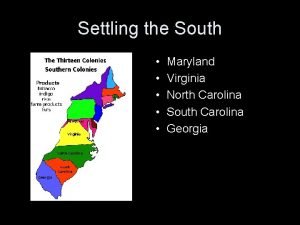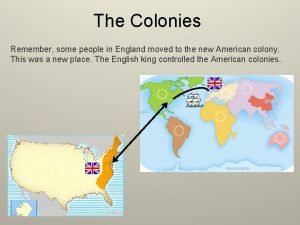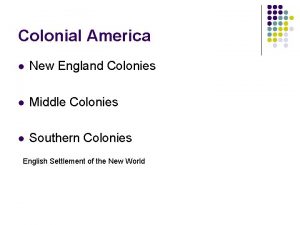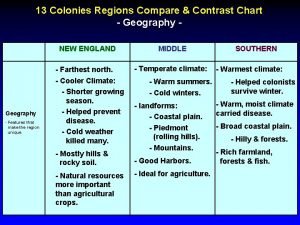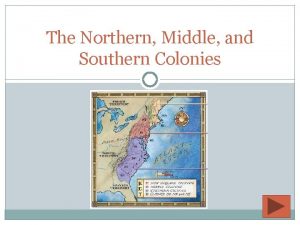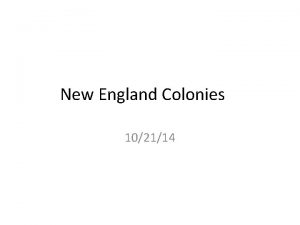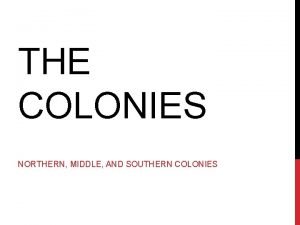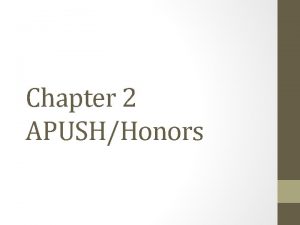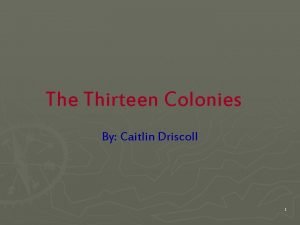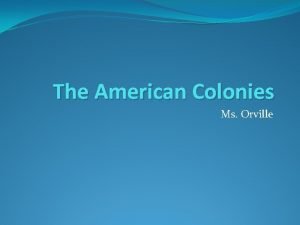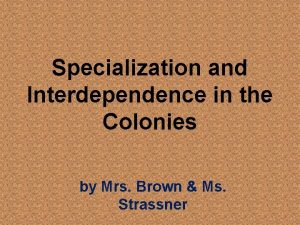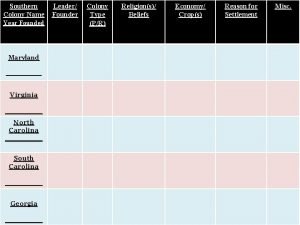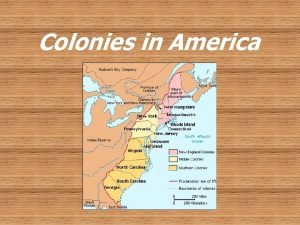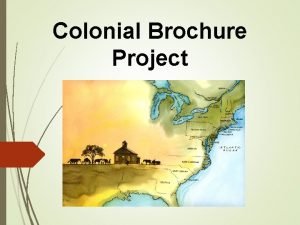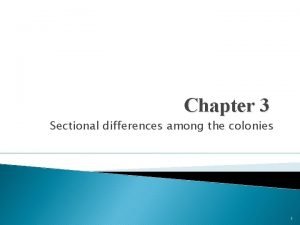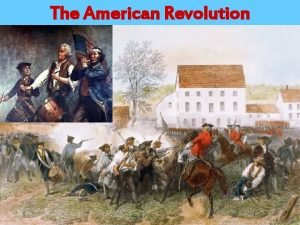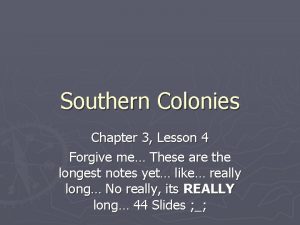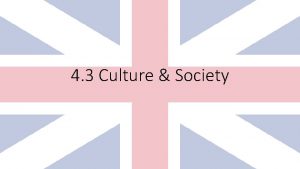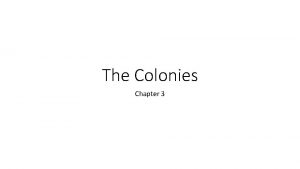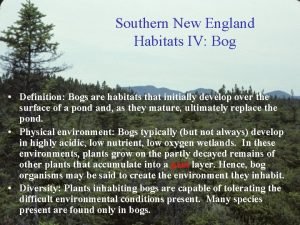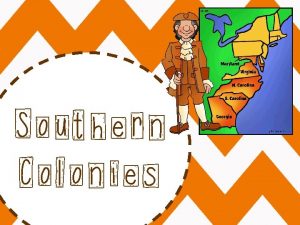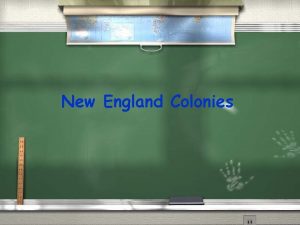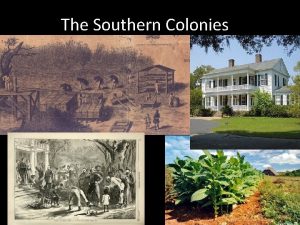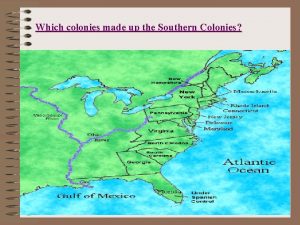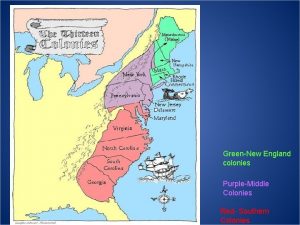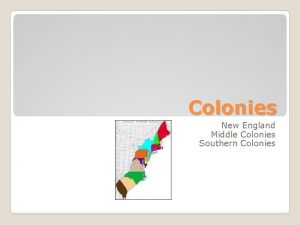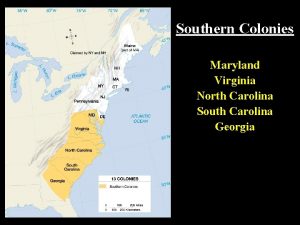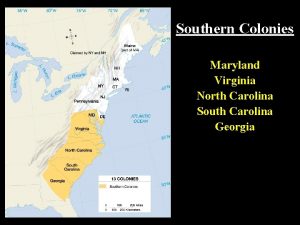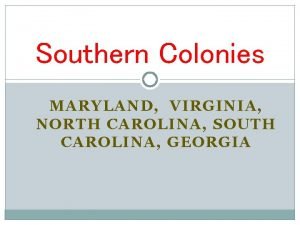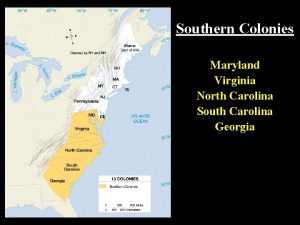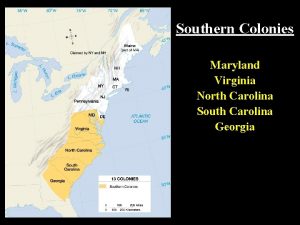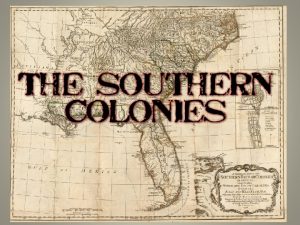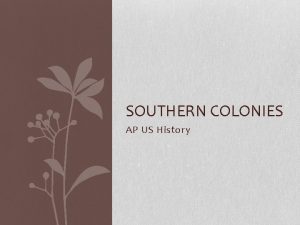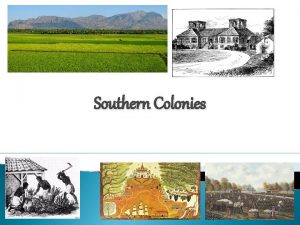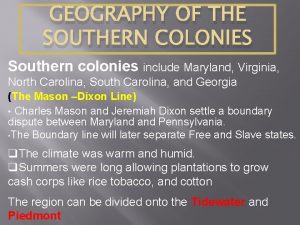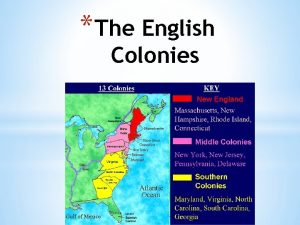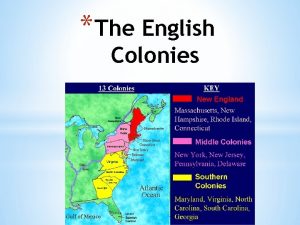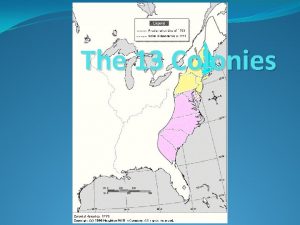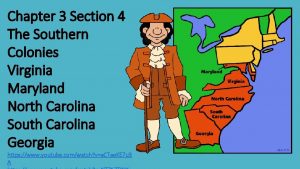SOUTHERN COLONIES SECTION FOUR A VIRGINIA AND MARYLAND























- Slides: 23

SOUTHERN COLONIES SECTION FOUR

A) VIRGINIA AND MARYLAND

THE SOUTHERN COLONIES By the 1660’s, the large tobacco plantations in southern colonies needed more workers to harvest the crops. The demand for indentured servants and African slaves increased.

SOUTHERN PLANTATIONS

LORD BALTIMORE (MARYLAND) In 1632, the proprietary colony of Maryland was established by Sir George Calvert, Lord Baltimore, as a haven for Catholics and a place to make him wealthy.

POTOMAC RIVER In 1634, Baltimore’s son brought 200 settlers to Maryland settled along the Potomac River where they grew tobacco. They also grew other crops like corn. Baltimore would soon become the largest port city in the colony. Maryland offered 100 acres of land to every settler who agreed to come to the colony.

“MASON – DIXON LINE” The Mason–Dixon line, also called the Mason and Dixon line or Mason's and Dixon's line, was surveyed between 1763 and 1767 by Charles Mason and Jeremiah Dixon in the resolution of a border dispute involving Maryland, Pennsylvania, and Delaware in Colonial America. It is still a demarcation line among four U. S. states, forming part of the borders of Pennsylvania, Maryland, Delaware, and West Virginia.

ACT OF TOLERATION The Act of Toleration was passed by Lord Baltimore to make sure that both Catholics and Protestants in Maryland could worship freely. This helped ease the tensions in the area.

VIRGINIA In the 1640’s, Virginia was growing wealthy with tobacco and settlers demanded to move farther west into Native American lands. The English governor of Virginia would not permit this.

BACON’S REBELLION Sir Robert Pork

BACON’S REBELLION Nathaniel Bacon led a rebellion in 1676 to protest the governor’s orders to stay out of Native American territory. Bacon and his men made it to the capital city, but he died of an illness before he could overthrow the governor. His death ended the rebellion.

B) THE CAROLINAS AND GEORGIA

CAROLINA In 1633, the proprietary colony of Carolina (Charles’ Land) was created by owners who wanted to make money by selling and renting land.

CHARLES TOWN (CHARLESTON) Charles Town became the most important city in the colony. The constitution of Carolina was written by the famed English philosopher John Locke.

NORTH CAROLINA & SOUTH CAROLINA Because the northern and southern parts of Carolina argued, they eventually separated. North Carolina was more backcountry, poor farmers while South Carolina had more wealthy plantation owners.

CASH CROPS Tobacco (far left), rice (top), and indigo (bottom) became the main cash crops in the Carolinas.

AFRICAN SLAVES African slaves were needed in huge numbers. More than half of the settlers in South Carolina were slaves.

ROYAL COLONIES By 1729, North and South Carolina became royal colonies. England took control to settle disputes.

GEORGIA

JAMES OGLETHORPE In 1733, the colony of Georgia was created by James Oglethorpe as a way to give English debtors a chance to start again. It also created a buffer with Spanish controlled Florida and the other colonies.

DEBTORS COLONY

SAVANNAH Eventually, Oglethorpe thousands of created the city poor Europeans of Savannah moved to and outlawed Georgia – not as slavery, many Catholics, and Englishmen as rum. they wanted. After many complaints over his rule, Oglethorpe turned Georgia back over to England in 1751.

THE 13 ENGLISH COLONIES
 Maryland virginia north carolina south carolina and georgia
Maryland virginia north carolina south carolina and georgia Northern colonies
Northern colonies Northern middle and southern colonies venn diagram
Northern middle and southern colonies venn diagram 13 colonies compare and contrast
13 colonies compare and contrast When was the new england colonies founded
When was the new england colonies founded New england, middle and southern colonies comparison chart
New england, middle and southern colonies comparison chart Northern middle southern colonies
Northern middle southern colonies New england mid atlantic and southern colonies
New england mid atlantic and southern colonies Religion southern colonies
Religion southern colonies Characteristics of the southern colonies
Characteristics of the southern colonies Southern colonies
Southern colonies Economy of southern colonies
Economy of southern colonies Southern colonies
Southern colonies Southern colonies specialization
Southern colonies specialization Southern colonies founder
Southern colonies founder New england confederation participants
New england confederation participants Southern colonies brochure
Southern colonies brochure Economy of southern colonies
Economy of southern colonies Southern colonies
Southern colonies Sports in colonial america
Sports in colonial america Chapter 3 lesson 4 the southern colonies
Chapter 3 lesson 4 the southern colonies Southern colonies society/culture
Southern colonies society/culture Southern colonies
Southern colonies New england colonies definition
New england colonies definition
